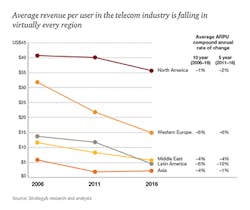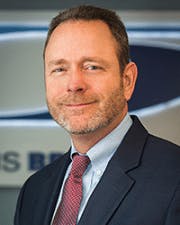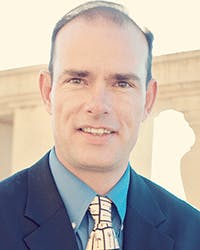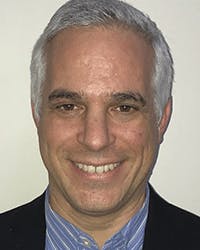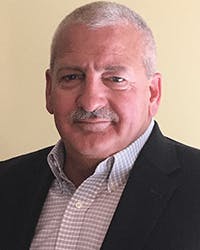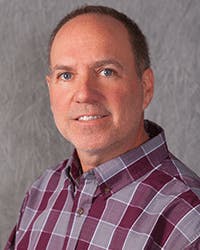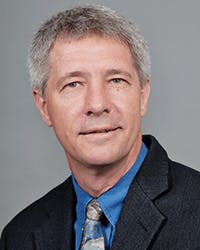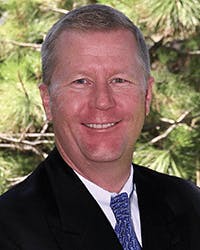Thought Leadership for Today’s Networks.
Learn what our Visionaries have to say about ARPU declines, data center evolution, rural networks, and also posing their own ICT questions. We asked our forward-thinking professionals to consider several questions, and to answer 3 of them. Read their insights in this last of a 3-part series.
ADAPTATION
Over-the-top (OTT) players, offering apps and streaming content directly to consumers through the Internet, have increased their dominance, even in core communication services such as messaging and voice. WhatsApp, Viber, and Apple’s iMessage, represents more than 80% of all messaging traffic, and Skype alone accounts for more than a third of international voice traffic minutes.
DATA CENTER EVOLUTION
Bringing data center technologies to the network’s edge is a development some predict may result in thousands of new mini-data centers at the base of the towers as more fiber from C-RAN is centralized in one location and data moves closer to the edge. Share your thoughts about the challenges and opportunities related to this.
FOCUS
Some say that technology can become a "shiny object" unless it’s properly focused on to solve needs for real-life customers. How do we make sure we are focusing on the right things, and not just on shiny objects?
RURAL NETWORKS’ SPEED DISPARITY
According to a 2016 FCC report, only 55% of rural residents have access to 25 Mbps speeds, compared to 94% in urban areas. That’s a sizable disparity. (Source: www.fiercetelecom.com) What are some of the best
solutions to correct this problem? Why will other solutions fail?
MY TAKE
Share one problem/challenge that you are passionate about solving in the ICT Industry.
ADAPTATION
One of the universal truths of a market is that, over time, customers are going to expect more at the same price or perhaps an even better price. This fact has a great impact on service providers and contributes to the significant cost constraints that challenge them.
While a shift away from old to newer technologies can help providers create more efficiency in their networks, the physical layer can present unique challenges in this regard. Cable and similar network elements are not readily changed as technology improves. Instead, telecom vendors must create products that serve current needs, while having the flexibility to cover future deployment technologies as well. An example of this might be an OSP cable that provides service over copper today, while also providing a clear conduit pathway for fiber deployment when needed in the future.
FOCUS
Our company has found success in following a simple formula. This is: an open, honest dialog with a customer throughout the entire process of creation will translate into a product that solves their problem. It is during
this discussion that assumptions can, and should, be challenged and refined.
During the early "problem definition" phase of a project, both customer and vendor jointly explore the nature of the network challenge, and what effects it may have on other elements as well as things such as quality of service. Our experience has sometimes been that the original perceived problem may be part of a larger issue, or can create unanticipated outcomes if solutions are not thoroughly vetted.
Ongoing dialog with many different disciplines within the customer’s organization has proven to be an effective method of bringing useful new products to modern broadband networks.
MY TAKE
Having achieved our share of success over the last decade, one of the greatest challenges we see in the industry is scalability. Whether talking about products or the companies that create them, the ability to move from small to large plays a pivotal role. Faced with this, we recently became a part of Amphenol Broadband Solutions, a global company whose management style complements the simple success formula I described in the previous question. This new corporate structure is allowing us to scale to meet the needs of a wider cross section of broadband service providers.
[toggle title=”Biography and Company Profile” load=”hide”]At Amphenol Broadband Solutions, Mike sets ABS’s technology vision. His organization is responsible for product innovation along with product roadmaps, product management and business development. Mike has over 25 years of telecommunication experience with an outside plant focus. The first 20 years of experience began at Raychem. Previous roles include product development, product management, and sales.
Email: [email protected]
LinkedIn: https://www.linkedin.com/in/michaelgrice
More information is available on the company’s website at www.go-asb.com
www.allsystemsbroadband.com
[/toggle]
RURAL NETWORKS’ SPEED DISPARITY
While it can be a challenge to bring high-speed Internet to rural and small town areas, we’re committed to using technology to expand Internet access to more locations.
As of June 2017, more than 70,000 locations can now access AT&T Fixed Wireless Internet in underserved or unserved areas across 9 states, as part of our FCC Connect America Fund commitment. The connection comes from a wireless tower to a fixed antenna on customers’ homes or businesses. This is an efficient way to deliver high-quality, high-speed Internet of at least 10 Mbps to customers living in rural and underserved areas, and has an advantage over satellite Internet since it’s not prone to high latency or interference from the weather.
We’re proud to expand our access in these communities. We plan to reach 18 states overall.
FOCUS
An important way to add value is to listen and consciously "use our powers for good!" We have amazing opportunities to solve real-world problems — FirstNet is a great example. FirstNet gives us an opportunity to put modern technologies that the general public uses every day — like smartphones and apps — into the hands of America’s first responders, helping them keep themselves and those they protect safe. And it will give fire, police, EMS, and other public safety workers, dedicated access to a wireless broadband network when and where they need it — 24/7/365, like their mission.
Another useful case is the Internet of Things (IoT), and the massive connectivity it affords. Some examples include:
• A healthcare data community with doctors, hospitals, pharmacies, and researchers, collaborating on analytics in a trusted environment that spans organizations, yet controls permissions.
• A smart cities coalition of governments and universities, conducting machine learning on broad sets of traffic data, without compromising on motorist privacy.
• You, taking a trip across the country and having your credit card and smartphone sync perfectly so that the card works for you, but not for someone who steals it.
MY TAKE
Creating capabilities for our company and our customers like never before — that’s the mountain we’re climbing. Network 3.0 Indigo is a game changer and we’re leading the way. The combination of software-defined networks, big data analytics, and advancements in automation, create the foundation for significant transformation throughout our platforms, products, processes, and people.
[toggle title=”Biography and Company Profile” load=”hide”]Claudia provides direct support to AT&T President of Technology Operations. Prior to this role, she led a large team including 1,400+ unionized field technicians that provide U-verse video and broadband services across Texas Southwest. Claudia joined AT&T in 1999 through the Leadership Development Program. During her years of service, she has served in numerous business units including network operations, marketing, and human resources.
*Global coverage claim based on offering discounted voice and data roaming; LTE roaming; and voice roaming in more countries than any other U.S. based carrier. International service required. Coverage not available in all areas. Coverage may vary per country and be limited/restricted in some countries. © 2017 AT&T Intellectual Property. All rights reserved.
www.about.att.com
[/toggle]
FOCUS
The Shiny Object Syndrome is something we in the ICT industry need to be keenly aware of given our incredibly dynamic environment and inner drive to solve problems. Keep reminding yourself that every single thing our teams do uses resources. Resources are finite. How do you filter out the distractions while still embracing change and still allowing for course corrections? I believe a strong process can be one method to help drive that business centered focus. Do your teams have a formal intake procedure to track new work? Setting up a process where leaders meet to vote on projects, debate the adherence to the long-term strategy, as well as ensure resources are assigned (and thus tracked) for proof of concept engagement, can provide the rigor needed to reduce uncoordinated side projects that can slowly drain resources.
RURAL NETWORKS’ SPEED DISPARITY
Serving customers in rural areas that have both reach and density challenges requires more than a single solution (like FTTP) which may not be currently viable.
CAF II (Connect America Fund) is helping with the economics of building to some of the unserved or underserved areas and that work can result in enabling higher speeds than the minimum. Additionally, there is ongoing expansion of fiber deeper into the wire centers. This leads to not only more 1 Gbps FTTP opportunities, but also being able to convert the rural T1-fed DSLAMs to fiber-fed equipment. This enables both bonding and vectoring on the existing copper — driving much faster access. Over the past several years, this combination of tools has enabled CenturyLink to expand higher speeds to many more of our customers with now over 9 million qualified addresses with at least 40 Mbps and over 3.5 million at 100 Mbps and above.
MY TAKE
I am passionate about driving faster understanding of the customer impact and source of service impairments. Many outages are simple failures readily root-caused, but complexity grows and performance is nearly as important as the up/down state of a service. Products now span multiple layers across various networks, each with different alarming, inventory, and support systems. I believe we can improve service by data mining the customer feedback, data from probes/NIDs, and core network element systems, to correlate issues enabling us to more quickly trigger customer notifications as well as self-healing actions or a guided fix.
[toggle title=”Biography and Company Profile” load=”hide”]Kristofer is responsible for the reliability and performance of CenturyLink’s nationwide metro Ethernet networks and broadband infrastructure supporting consumer, business, and wholesale customers. Kristofer has been with CenturyLink for 20 years in various Engineering, Planning, and Operations roles and holds a Bachelor’s degree in Mechanical Engineering from the University of Minnesota and a Master’s in Management from the University of Denver, Daniels College of Business.
ADAPTATION
We all need to focus on fiber transport and Cloud services/applications. Positive, mutually agreeable relationships among carriers, and vendors of such services, are critical to continue a revenue stream that will diversify the current product portfolios. Typical as-we’ve-always-done-it mindsets and product offerings will become obsolete in just a matter of time. Next-generation data consumers are rapidly changing the way they use data, and typical structures that provided our sense of "secure" revenue is dying. Vendors and providers alike will need to be one step ahead of consumers. Their relationships and product offerings will need to marry like they have never before to survive this landscape of evolution.
FOCUS
Too often, companies and individuals tend to spread their resources way too thin, looking to hook the big fish with a thousand casts and different kinds of bait (pardon the fishing metaphor, but it works), when they should be looking at a simpler idea, a (possibly) modified version of what works: patience, and a nice fat nightcrawler.
Focus comes from simplistic forward thinking. In my opinion, the easiest way to stay focused is to take a direction from leadership. For example, build a fiber network, and do it in the simplest way possible. Try not to reinvent the wheel. We have been extremely successful in our build out, taking tried-and-true methodologies we learned in the copper plant design and construction of the past 100+ years, and applying them to our copper build (with a few tweaks, of course). Know your customers. Determine what they will require in the future, accommodate, and keep them with good service today, and when tomorrow comes, you’ll be the first one capable of handling all of their needs.
MY TAKE
Obsolescence. Our company has been around for 140+ years, and that is one of many things that make me proud to be a part of such a great organization. We are constantly evolving, and it continues to bring success.
I enjoy my work, enjoy the history of the industry, and will continue to work towards tomorrow as we’ve always done. With new technologies, and great minds working together, we can all remain relevant for many years
to come.
[toggle title=”Biography and Company Profile” load=”hide”]Sean Flora oversees the OSP construction build initiatives including GPON, VDSL, and Ethernet fiber builds. His team supports Sales, PMO, Engineering, and Construction departments to work together to overcome inevitable obstacles, and keep projects on track. Sean has a diverse background, working across a variety of areas of the Company, and uses this to coach and guide his team to drive success for the Company, employees and customers.
Email: [email protected]
LinkedIn: https://www.linkedin.com/in/sean-flora-cfot-itil-54675586
ADAPTATION
The secret to survivin’ is knowin’ what to throw away and knowing what to keep. So goes the line from the popular Kenny Rogers song The Gambler. Basic communications revenue sources are no doubt at risk, but the safest bet is to invest in services that yield higher ARPU that are fiber-based and provide users a better online experience. North American FTTH is hitting record growth, and investments in deployment methods that lower TCO are smart. The smart money is on the Last Mile where technology advancements like pushable fiber through protected microduct pathways are creating revenue opportunities in buildings once deemed impossible to serve with fiber. Place your bets. At Clearfield, we are all in on fiber!
FOCUS
Clearfield was created because we had a clear vision of what we wanted to do but were grounded in our approach enough to make it practical. Lots of technology companies lab engineer their solutions. Clearfield "field engineers" the solution. Competitors may have great theories about products that lead to shiny objects, but
our engineers are in the trenches with our customers ensuring their field viability. For example, dB loss on a fiber infrastructure is intrinsic to protect performance when you go to higher and higher speeds. When you start turning up 10 and 40 gigabit circuits (shiny objects), it is ridiculous to think that a $10 patch cord might take down an entire network due to poor quality. That’s why we engineer FiberDeep patch cords that guarantee performance at .2dB insertion loss, which is half that of the industry standard.
MY TAKE
My dad was a "phone man" for 30 years before retiring from AT&T. I looked up to him and followed in his footsteps starting my career with AT&T — just like Dad. Now 30 years into my own career, I am passionate about fiber deployment because I have seen it create value for network operators and their customers, promote economic development, and enhance the quality of life for its subscribers. I have spent the last decade as a leader volunteer at the Fiber Broadband Association (formerly the FTTH Council Americas) to accelerate deployment of all-fiber networks. There are a number of studies that illustrate this truth. I think Dad would be proud.
[toggle title=”Biography and Company Profile” load=”hide”]Kevin has vast experience in communications technology, fiber optic systems, and business product marketing. He began his career at BellSouth (now AT&T) leading product evaluations of broadband technologies, and also led product management and marketing efforts at ADTRAN for 20 years. He is well known in the industry for his leadership at the FTTH Council. Morgan holds a Bachelor’s in Electrical Engineering (Auburn) and an MBA (Alabama).
Email: [email protected]
Twitter: https://twitter.com/kevinmorgan520
ADAPTATION
It’s time to get resourceful and keep a positive attitude! Coming up with additional revenue streams can be challenging — but what if it wasn’t? One method is to make the battery backup an enhanced service by keeping Internet up during an outage. It costs you almost nothing yet can provide a valuable service to your customers. Internet can be more valuable during an emergency than a landline phone yet most providers are disconnecting Internet after a few minutes of a power outage. Can you keep your customers wireless up during an outage? Could this be another revenue stream? For years, we had maintenance plans for inside wiring at the customer premises. Why not enhance that to include keeping Internet alive during an outage? We are starting to see providers offering this as an additional service for a few dollars per month.
DATA CENTER EVOLUTION
My mantra of "many small devices is more powerful than a single large device" will continue to prove true. We have already seen this as the technology keeps getting closer to the customer. It helps with delivery speed and bandwidth efficiency.
MY TAKE
I hope you quickly understand just how passionate I am about building the best UPS and solar power products on the planet! My team and I are always looking for ways to solve the powering challenges facing our customers: innovative ways to improve reliability as well as save time and money. This passion is evident in all our products. One example of this passion is our Voltar solar product. We were the first in the world to solve the challenge of powering an ONT without utility power while also including the UPS alarming. If you are also passionate about reliably powering network devices, I want to meet you. Contact me, and let’s talk!
[toggle title=”Biography and Company Profile” load=”hide”]Chris has more than 20 years of telecom engineering experience, and has a passion for powering things. He was instrumental with one of the very first IPTV-over-copper deployments in the US. He was also the 1st MEF CECP engineer in Oklahoma. He holds multiple patents and continues to create innovative ways to power network devices, including the award-winning Voltar solar UPS. He lives in Stillwater, Oklahoma, with his wife Paige and two Westies.
Email: [email protected]
Tel: 806.282.1363
RURAL NETWORKS’ SPEED DISPARITY
Providing broadband service to rural communities is a priority. We believe the best approach is a "combination" of solutions. For example, our engineering teams can replace older DSLAMs with VDSL, vectoring and G.fast technology, or Fixed Wireless Broadband, or extend our fiber network to customers for FTTH access. We leverage every opportunity to extend our fiber network closer to our rural customer base to provide connectivity and speed.
FOCUS
Before we can select the right technology, we analyze the issue we are trying to address. Is this a material problem for our business? Is it a problem for others in similar situations? Is the solution proposed economically viable? If the proposed solution solves a key problem for multiple companies, it makes sense to pursue it. If it is a niche application, there may be a place for it, but it may not get the funding it requires to mature into a solution that can scale. New technologies must improve the customer experience, and be efficient and cost-effective for both customer and supplier.
ADAPTATION
Frontier, like its wireline peers, is seeing pressure on revenues, ARPU, and capital expenditures from increased OTT traffic on its network and competition in general. The FCC’s pending proceeding to repeal Title II regulation from broadband would be a positive first step, but Frontier believes there is value in developing strategic partnerships with OTT providers. These alliances can mean working with OTT providers to market services to customers directly; hosting or collocating OTT providers’ equipment to place it closer to customers and improve the user experience; and developing cost recovery methods to offset rapid OTT traffic expansion. Operators like Frontier can provide a great network and simplify distribution to customers. In turn, our OTT partners would help Frontier provide customers with innovative products and services.
[toggle title=”Biography and Company Profile” load=”hide”]As Director of Network Engineering, Diane is part of the team responsible for the implementation and FCC reporting of the Connect America Funding build for Frontier’s 29 states, as well as leads the Fiber-to-the-Cell build team. She is also responsible for managing acquisition-related projects to ensure Frontier meets their obligations associated with its most recent purchase of properties in California, Florida, and Texas. Diane has over 25 years of telecommunication experience in Engineering and Project Management.
DATA CENTER EVOLUTION
A renaissance is taking place in the way fiber networks are engineered to support C-RAN and other dense fiber applications. C-RAN enables cell densification by leveraging CPRI over fiber standards as well as proven xWDM technology to achieve phenomenal centralization of the pool of BBUs. What is often overlooked is the implication this places on the fiber infrastructure needed to support the centralized baseband sites. CPRI front-haul, as well as the associated transport network backhaul, creates new challenges which require creative approaches to addressing high-port count, and high-density fiber management in the OSP as well as back at the centralized BBU sites.
Of course, it’s not just C-RAN which is driving this urgent need. Cloud, NFV, IoT, NG-PON2, and CORD design are all examples of industry mega trends driving greater fiber densification throughout the network. As an innovation-driven developer of high-density fiber connectivity solutions, at Go!Foton we see this as yet another opportunity to contribute to the rethinking of fiber management at the Central Office, Data Center, and OSP cabinet locations.
Conventional fiber management systems are often designed around a highly centralized and monolithic approach to fiber connectivity. These low-density fiber systems also employ highly proprietary systems which limit the ability to support new technologies and applications. The Go!Foton PEACOC HD fiber management platform supports this ubiquitous densification by providing a more efficient and cost-effective way to scale and manage decentralized optical connections so as to support the explosive growth in fiber density. Effective HD connectivity solutions such as PEACOC easily integrate a multitude of different fiber management functions while providing service providers with a highly compact and space-efficient platform which is versatile, easily reconfigurable, and extremely craft friendly.
FOCUS
Chasing "shiny objects" is usually characteristic of an undisciplined approach to decision-making. Whether it’s a particular technology or a new product, there needs to be a structured process with clearly defined criteria which will allow evaluation of both the shiny object and also the impact it has on meeting the needs of the service provider or real-life customers. Using a cross-functional approach which integrates multiple perspectives is often a good way to ensure that one doesn’t get too easily distracted by the allure of "shiny objects".
[toggle title=”Biography and Company Profile” load=”hide”]Michael is responsible for the Connectivity Business Unit. Although an engineer by training, Michael is an accomplished global business development and telecom management executive with a perspective for identifying and growing strategic business opportunities. Most recently, Michael was Managing Director of the Network & Product Integrity Group at Telcordia Technologies.
Email: [email protected]
LinkedIn: https://www.linkedin.com/in/michael-zammit-2183812
ADAPTATION
The telco industry is currently in the throes of a shakeup, as new startups and OTT players upset the status quo. Emerging ecosystems based on Internet and "as a service" technologies are creating new threats and opportunities. To stay relevant during this disruption, Traditional CSPs and Telco Vendors must evolve at warp speed.
Next-Gen CSP need to be a truly open digital enterprise and offer personalized communication and services to customers, while allowing ecosystem partners to combine products and services to create new offers, services, platforms, and components.
An "All-IP" Virtualized infrastructure requires New Age telco vendors and system integrators to proactively prepare to fill the voids due to huge changes in workforce skills, business models, and execution speed. They also need to support complex technology integration and multi-tiered partner ecosystems.
DATA CENTER EVOLUTION
Traditional data centers are changing, with compute and storage resources moving closer to the user (edge). Challenges associated with edge computing include productization of the hardware/software solution, the advent of white box, wide scale deployment, multivendor support, life cycle management, and the lack of tools and automation.
Service providers will lower operational costs while increasing revenue through enhanced services enabled by edge computing. Rapid distribution of new software-based services via self-provisioning systems will reduce time-to-market for revenue-generating services.
For service providers, selecting partners that understand edge computing, can validate and support hardware/software solutions, and support deployment and life cycle management, will be key to success.
MY TAKE
Service providers are under pressure to manage the exponential growth of data flowing through their networks while keeping costs under control and providing more and improved services to customers. The struggles found in these POCs have highlighted the need and opportunity for a holistic effort to help providers realize the full benefits of NFV. Because of these challenges, network operators are being forced to serve as solution integrators, a role for which they lack the appropriate skill sets, resources, and time.
NFV migration challenges cannot be solved by a single company or institution. Innovation centers, such as the one at KGPCo, incorporates solutions from a multiple partner ecosystem to overcome the challenges of NFV integration. It provides a cooperative effort to bring all stakeholders across the industry, inclusive of standards, technology partners, and service providers — resulting in a combined expertise and experience required to solve the systemic challenges of NFV migration and integration.
[toggle title=”Biography and Company Profile” load=”hide”]Paul focuses on the Telco, Cloud, and Virtualization partner ecosystem. He is tasked to lead sales, strategy, and long-term planning for growth for KGPCo as customers transition to the Cloud and virtualized environment. Paul brings 31 years of experience and leadership in the Telecom sector in sales and operations. Preceding KPGCo, Paul held various positions at TE Connectivity, and at BellSouth Telecommunications in the IT and Network organizations.
FOCUS
The saying that "Hindsight is 20/20" seems very relevant to this topic. Historical data offers insights into new areas of focus. In telecom, we frequently see "shiny objects" surface in a number of ways that build excitement and anticipation. Often, they are in proof of concept, beta, or under development, and need to reach general availability before they actually solve customer’s needs. For example, when radiotelephones were cutting edge, it allowed us to make a phone call over a radio — if we were in coverage. Today, we ask our car to make the call while parking itself and dropping us at work. Shiny is cool! Solving real-life customer needs is essential. It takes patience, understanding, and consistent evaluation of new solutions and their possible fit to solve customer needs — before we can create a plan to deploy them.
RURAL NETWORKS’ SPEED DISPARITY
TDS is committed to ensuring customers have access to high-speed Internet service. In addition to researching new technologies that will enable us to expand our speeds, TDS also actively engages with federal, state, and local governments, to leverage funding to improve our broadband service. Back in the ‘50s and ‘60s there were government programs to ensure electrical and telecommunication services were available in rural areas. Today, programs such as Alternative Connect America Cost Model (A-CAM), make it possible to expand fiber to unserved households, regardless of the distance between homes. In fact, it’s the distance that oftentimes makes infrastructure expansion cost-prohibitive. Funding plus flexible designs that combine fiber and copper will allow us to continue to extend fiber optics deeper into the network, provide innovative solutions, and make advancements in technologies such as bonded VDSL2 and Vectoring.
MY TAKE
Technology innovation is on a steep incline, however, nearly all require more bandwidth and greater access to broadband. Fiber is very healthy and will satisfy insatiable appetites for broadband speeds. Our challenge, as ICT leaders, is to deliver similar services in both rural and urban areas along with delivering a superior customer experience that delights the customer. As leaders, we must champion economic development by providing reliable communication service. We must also innovate and improve, and as technology changes, evolve and adapt. Extending fiber deeper into our network will ensure faster and more reliable speeds, but it must be coupled with having a strategy that supports continuous improvement for our network and infrastructure.
[toggle title=”Biography and Company Profile” load=”hide”]Bob Perkins has nearly 35 years of experience in the telecommunications industry. In his current role, Bob oversees ILEC, CLEC, and cable operations for TDS Telecom’s Western Region. He started in the business as a technician in the US Air Force and holds a bachelor’s degree in Business Administration. Bob joined TDS in 1994. When not at work Bob spends time with his wife of 33 years and their 2 daughters (or bass fishing). Bob is passionate about the environment, and leads efforts focused on water quality and appropriate land use.
Email: [email protected]
FOCUS
Our industry has plenty of shiny new solutions looking for problems that don’t exist. Unfortunately, these solutions dilute resources and generate unnecessary distractions as opposed to actually moving us forward. The best thing we can do as network operators is clearly articulate our biggest problems and allow suppliers to focus on them as opposed to reinventing the wheel. Bottom line, engineers love to solve problems but we, as an industry, need to narrow the focus to what is really important for our customers.
RURAL NETWORKS’ SPEED DISPARITY
Having grown up in rural Kansas, I can assure you that network speed is not the only service with similar disparity. Try hailing a cab, seeing a medical specialist, or catching a newly released movie. That being said, broadband is one issue that can and will be solved. The best solution is wireless, given that it provides both large coverage areas and mobility. But even that requires deep fiber penetration for high throughput. The challenge has always been a reasonable business case. Local, state, and/or federal government subsidies have worked in the past and could quickly solve this issue if they made it more attractive for network operators.
MY TAKE
Making fiber ubiquitous. Copper goes to every home, apartment, business and street corner appliance (sensors, meters, cameras, stoplights) in the country. It literally goes down every street in our cities and nearly every road in our rural areas. Much like electricity, it was considered mandatory at one time and served us well for a century. But it is time for a technology uplift. I’m not saying wireless can’t and shouldn’t be used for access whenever possible, but it still needs connectivity. Fiber isn’t new and there isn’t anything better on the horizon. We need to make it as common in the 21st century as twisted pair was in the 20th century if we are going to remain a world leader.
[toggle title=”Biography and Company Profile” load=”hide”]Glenn Wellbrock is responsible for the development and deployment of new technologies for both the metro and long haul transport infrastructure. A well-respected presenter on optical technology, Wellbrock holds numerous patents in optical technology and is considered an expert in the field. Prior to his current position, Wellbrock ran the advanced technology lab, established evaluation criteria, and set engineering guidelines for all backbone transport equipment. He has more than 20 years at Verizon.
ADAPTATION
It’s pretty clear that if you are in the access business, be it wireless or wireline, commoditization has been and continues to have a large impact to the bottom line through ARPU compression. That impact translates directly to vendors as carriers work to manage both capital and expense costs. Carriers must ensure they provide businesses with solutions that help enterprises engage their clients and grow their businesses, to provide them with a value proposition that establishes the carrier as a trusted and valued partner in the business’s growth and evolution. Digital simplicity and clarity is key in this effort, and it must be back-stopped with high levels of service assurance and personalized support that repeatedly demonstrates the partner proposition.
FOCUS
Focus followed by execution around customer-centered solutions that help customers evolve their businesses
or simplify life at home is key. At the current pace of innovation — which will continue to accelerate — it means figuring out the right focus areas where a provider can be exceptional and distinguish themselves. But needed solutions may extend beyond core competencies and customers are increasingly savvy, so building strategic partnerships with key innovators who fulfill non-core strengths is key. It can help fill the gap while maintaining digital simplicity. It also sets the stage for an "all-in-one" value proposition that also reduces customer cost and complexity compared with multiple independent services cobbled together.
RURAL NETWORKS’ SPEED DISPARITY
Cost and geographic challenges remain the primary obstacles in leveling the disparity between rural and urban areas. Fortunately, there are a variety of solutions in the toolbox to help. Technologies such as line power to reduce power infrastructure costs and permit lead times, cascaded splitter and micro-duct OSP architectures, and alternatives to pad-and-cabinet infrastructure, help lower the cost and speed implementation. In some cases, fixed wireless may also play a role. The key in all of this is cost as the dispersed customer nature versus an urban environment puts greater pressure on investment payment.
[toggle title=”Biography and Company Profile” load=”hide”]Karl-Arne "K-A" Hegewald has 17 years telecommunications experience, and supports the Transport Network Engineering team at Windstream. K-A was previously Director of ISP Planning and Engineering, supporting Windstream’s power and environmental engineering teams, the colocation engineering team, and the colocation coordination team. His prior experience also includes supporting strategic planning, transport engineering, and engineering project management teams at Qwest/Centurylink.
Email: [email protected]
URL: www.windstream.com
Windstream Holdings, Inc. (NASDAQ: WIN), a FORTUNE 500 company, is a leading provider of advanced network communications and technology solutions for consumers, businesses, enterprise organizations and wholesale customers across the U.S. Windstream offers bundled services, including broadband, security solutions, voice and digital TV to consumers. The company also provides data, cloud solutions, unified communications and managed services to small business and enterprise clients. The company supplies core transport solutions on a local and long-haul fiber network spanning approximately 147,000 miles. Additional information is available at windstream.com. Please visit our newsroom at news.windstream.com or follow us on Twitter: @Windstream.
www.windstream.com
Social Media: @Windstream[/toggle]
Save
Save
Save
Save
Save
Save
Save
Save
Save
Save
Save
Save
Save
Save
Save
Save

